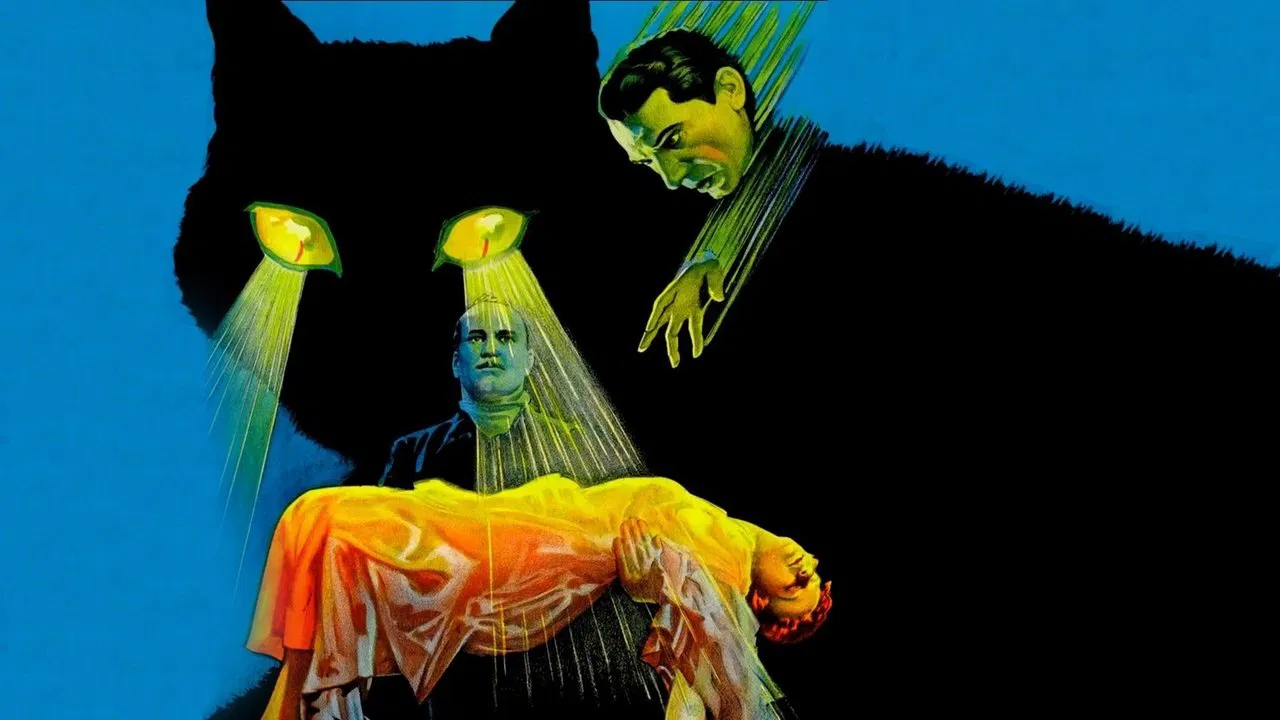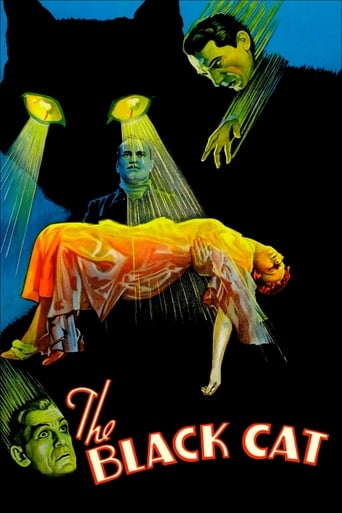

The greatest movie ever made..!
... View MoreDid you people see the same film I saw?
... View Morebrilliant actors, brilliant editing
... View MoreThe movie's not perfect, but it sticks the landing of its message. It was engaging - thrilling at times - and I personally thought it was a great time.
... View More"The Black Cat" from 1934, is the best of the Karloff/Lugosi collaborations. Never again in their future films together would both actors have equal screen time and be equally relevant to a films plot. This makes for rather grim viewing (apart from a brief comic interlude) but the way in which this film is cast, directed, written and photographed makes for a gripping and fairly original horror film. The plot owes very little to the short story from Edgar Allan Poe but that slight reference is of no importance.For once, Bela Lugosi is cast against type as he is a more sympathetic character - even though he is still a bit unhinged!Boris Karloff is pure evil as the leader of his own group of Satanic followers. He is also the one responsible for betraying a number of his fellow countrymen during the first world war - Lugosi included.It is the performances of Karloff and Lugosi that stand out - they compliment each other very well.The American film censors weren't happy with the final version of "The Black Cat" and as a result, they instructed "Universal" to shoot additional footage in the hope of making the film more fit for public exhibition. During the extra filming, the director Edgar Ulmer managed to sneak in a scene that went by the American film censors without realising what a controversial scene it was!One of the best horror films from "Universal's" first horror cycle.
... View MoreI have to admit this is one of my all time favorite films. Edgar Ulmer created one of the most chilling horror/fantasy odysseys in film history.Karloff and Lugosi are brilliant in their portrayals of the antagonists Hjamar Poelzig and Vitis Werdegast. The setting is a modernistic and nightmarish Hell House designed by the Satanic architect Poelzig which is wonderfully realized by Ulmers direction and set design, John Mescal's camera work, and Heinz Roenhelds eerie musical score. Peter Ruric's screenplay contains some of the most quotable lines in horror movie history, including my all time favorite " You see Vitus, in this house even the phone is dead," The Black Cat was released in 1934 and outraged so many critics at the time that it it help inspire the Catholic League of Decency and it s moral code for motion pictures which became the industry standard for many years. With that and Ulmer "Stealing" the wife of Carl Laemmles nephew, Ulmer was banished to poverty row film making for the rest of his career.
... View MoreThe first pairing of horror legends Bela Lugosi and Boris Karloff & frequently throughout these pairings, it was Karloff getting top billing over Lugosi. And I think there has been some debate raging for many years between classic horror fans on whether this film or "The Raven" is the superior movie.Maybe depending on one's own personal tastes--as to whether you prefer Karloff or Lugosi--may decide which film you think is better. Personally speaking, I think in most cases I would say I'm more of a Bela fan than Boris, which is why I would vote for "The Raven" being the better movie- -although here in "The Black Cat", the 2 horror legends are on equal footing in this macabre tale suggested by Edgar Allan Poe.The movie centers around Dr. Vitus Werdegast's (Bela) motivation to kind Hjalmar Poelzing (Karloff) and avenge the wrongs Karloff has done to him--namely, leaving him for dead during the Great War and marrying his wife and adopting his daughter. Of course, Karloff's Dr. Poelzing may have murdered Werdegast's wife, just as he would eventually murder his daughter, Karen.To say that the Poelzing character is a weirdo would be an understatement. A practicing Satanist, he intends to use the requisite love interests of this movie as a sacrifice in some Satanic ritual."The Black Cat" is a much more methodical film than the followup, "The Raven"--whether that's good or bad may depend once again on one's personal tastes. The film seems to simmer along at a slow pace to start then picks up steams in the last 2 thirds of the film I would say. While not as in your face or as gloriously over the top as "The Raven", "The Black Cat" may work better as a more cerebral thriller.8 stars
... View More"The Black Cat" remains a fascinating film. It must have been like an explosion for audiences in '34. Unlike many of the horror films of the period, the picture is decidedly modern. Its horrors didn't come from supernatural creatures, ghosts, or even bloodless mystery/thriller murders. Instead, it deals with topics like war crimes, torture, Satanism, and implications of necrophilia, rape, and incest. "The Black Cat" hasn't aged a day and remains as potent, stylish, and horrifying now and when it first premiered.Technically, the movie looks fantastic. Hjalmar Poelzig's mansion today looks a bit like a swanky art-deco apartment. It's still a bizarre location, with glass screens randomly bisecting rooms and round swivel chairs artistically placed. As strange as the living room looks, no set stands out more then the Satanic altar at the end. A huge double-t leans against the main altar, like an overturn crucifix. Poelzig, dressed in a red robe, leans against an X-shaped podium. Behind him, a giant pipe organ stands, an odd, crystal-like shape emerging from it. Probably the movie's most famous bit of art design evolves the perfectly preserve body of Bela Lugosi's dead wife, floating in the middle of a glass tube, her hair up on end, like an underwater angel.The creativity extends to the film's direction. Edgar G. Ullman, who later directed surreal film-noir "Detour" and sci-fi favorite "The Man from Planet X," worked on many of the most famous German Expressionism film. (He blatantly references F.W. Murnau's "The Last Laugh," with a verbose cab driver character.) Karloff's introduction involves a slow pan into a bedroom, a white sheet hanging over the bed. A near-nude woman lays beside him as he rises up, totally silhouetted in shadow behind the sheet. Upon seeing Jacqueline Wells as virginal bride Joan, in the forefront of a shot, we see Poelzig clutch a statue of a nude woman, visually illustrating his desire to own her. The shadow of a black cat is cast huge against Lugosi, causing him to fall backwards into a glass wall, drowning in his own phobia. The Black Mass is full of creative angles, starring down at the organ keys, quick cuts between the Satanic worshippers' faces. My favorite moment in the film is one of the most dream-like and inexplicable. As Karloff speaks in voice-over, a monologue about the game Lugosi and him are about to play, about how similar they really are, we the viewer are led on a first-person perspective tour through the underground chambers of the mansion, through the secret doors, up the winding staircase. It's a spellbinding moment. The film is important for its extensive use of music, a daring move at the time. It's a great score too, dark and dreamy, providing exactly the tone needed for the story.Casting the two towering legends of horror as rivals in a game of cruelty is the film's most brilliant masterstroke. Casting both against type was also a surprising move. Hjalmar Poelzig is probably Karloff at his most sinister. The usual whimsy in his eye gives way to a detached psychosis. His mind is cunning but utterly cold. Inspired by Aleister Crowley, Poelzig cuts a sinister figure. His close-crop hair cut, extravagant outfits, and slight eye-liner makes him look like a time-displaced David Bowie. Even then, Karloff can't help but make the guy a little sympathetic. When gazing upon the dead wife's face, he speaks not with a dangerous obsession, but instead a sincere love of her beauty. The hatred that burns between Poelzig and Wendegast is legendary. Wendegast has spent his entire life obsessing over vengeance, determined to unleash his rage on his tormenter. Poelzig meanwhile has gone out of his way to steal or destroy everything Wendegast loves. Took and murder his wife before, never once questioning the incestuous circumstances of the move, marrying his own step-daughter, just to destroy his rival's sanity. Lugosi's gave-it-his-all theatrics works perfectly for a man consumed by revenge. Though toned from the original script, the movie makes it clear that neither man is sane. Both are dangerous, roping the innocent married couple into their deadly game of chess.Not that David Manners or Jacqueline Wells give bad performance. They both do quite well and have a funny, natural chemistry together. But they're outsiders, exiles in the freakish, nightmare world "The Black Cat" inhabits. No doubt they were intended as audience surrogates in 1934.Climaxing with a still disturbing, explicit moment of torture, "The Black Cat" can still raises goosebumps. I wonder if Chan-Wook Park or Jee Woon-Kim have seen it, since you can draw some parallels with their revenge epics. It's a masterpiece of classic horror, floating across the screen like a filmed nightmare.
... View More